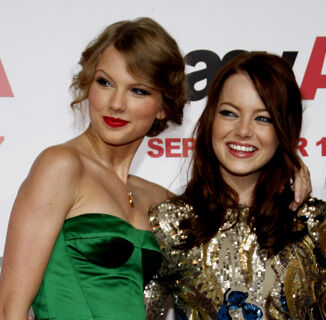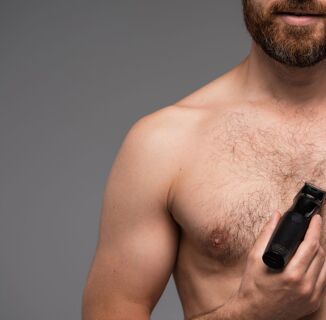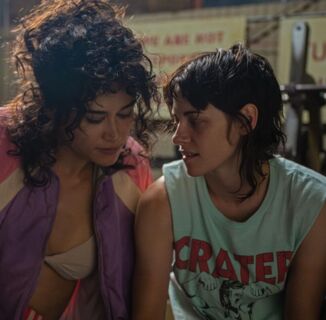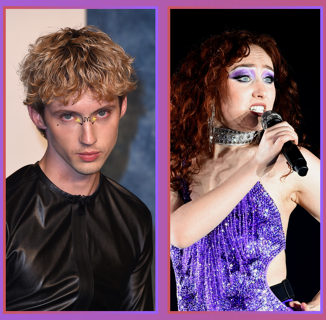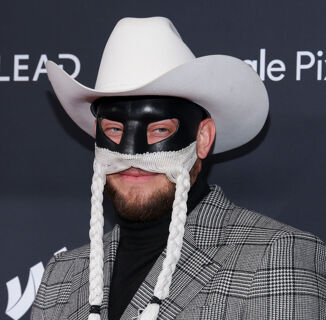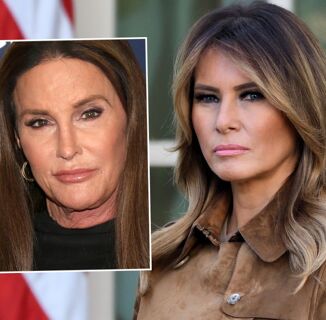As soon as the song “Girls” came out, I received several messages from friends, asking my thoughts. Some were looking for me to share their outrage over big names co-opting bisexuality, while others were fans of the catchy bi-affirming bop and were hoping I’d give them my blessing. On Twitter, openly queer artists like Torres, Kittens, Kehlani, and Hayley Kiyoko called the track out for appropriating queer culture and selling, literally, the same old Sapphic-tinged song about getting just tipsy enough to take a dip in the lady pond.
The song, Rita Ora’s with cameos from Charli XCX, Bebe Rexha, and Cardi B, is an homage to Katy Perry’s “I Kissed a Girl,” according to Ora, who wrote the track with six men (three of whom produced the track) and one other woman. (Cardi B penned her own verse.) The male gaze (ear?) is apparent in the lyrics that inevitably make “Girls” a stereotype-perpetuating pop track about women feeling drunk and bored enough to have a dalliance with a lady friend. Ora eventually apologized for offending fans and peers but also wanted to make her own bisexual identity clear. She was singing, she says, from her own experiences, which is that “sometimes she just wants to kiss girls, girls, girls.”
Clearly, queer women were finding themselves conflicted with the kinds of visibility being offered in 2018. Ten years ago, “I Kissed a Girl” provided a public nod to bisexuality that was as problematic as it was popular. There was still an argument made by supporters (aka those who have a thing for straight girls or identify as straight girls) that the song was about a very specific experience, one that shouldn’t be dismissed or ignored. The fact that “I Kissed a Girl” received much more support and radio play than songs about the lesbian or bisexual experience from out lesbian or bisexual artists, though, was worth noting, as was the noticeable marketing push for Perry to play coy about it being based in any truth. (The story has changed many times, but most recently, Perry says she would make significant changes to the song now, having listened to LGBTQ fans and critics of the song’s mention of her boyfriend’s approval and other stereotypical stanzas that further myths about bisexuals.)
The other three women on “Girls” have also spoken about being sexually open, though every verse is a more cheeky delivery of fleeing flirtatious curiosity than an affirmation of non-heteronormative romance and relationships. What could have helped this narrative would have been to make a killer queer music video; one in which lesbian and bisexual women saw themselves reflected unlike Perry’s “I Kissed a Girl” which, infamously, included zero girls kissing. (Instead, just Perry delivering a lot of come-hither looks and a slumber party full of feminine women definitely not making out with each other.)
The “Girls” video, out today, was directed by (wait for it!) a man, and has very little kissing. Instead, it’s shots of Ora delivering a lot of come-hither looks and a slumber party full of feminine women definitely not making out with each other. (Stop me if you’ve heard this one before!) They’re wearing lingerie and all have identical soft blonde curls to those Ora sports, one of the video’s first nods to narcissism, a stereotype that plagues lesbians or anyone who dates the same sex. Bebe Rexa’s scenes has her kissing her own reflection in the mirror, no other girls in sight. (Cardi’s verse includes “I’m too sexy, I seduce myself,” furthering the theme.) Charli XCX is singing amongst wandering women in white in a wooded area, and there’s a brief shot of two women caressing one another in some illicit, secretive cruising scenario.
Then there’s Rita and Cardi as holograms, Cardi using some Gene Simmons-esque tongue tricks to show off her perceived expertise. When Cardi and Ora share a peck on the lips, it’s hard to tell if the two women were edited together or actually in the same room. Either way, there’s no chemistry like there was in Kiyoko and Kehlani’s video for “What I Need” released this week, nor the Syd-directed video for The Internet’s “Come Over,” also out today. As the only actual kiss between women in the video, it’s without passion or longing. It exists purely for titillation and, surely, attention-grabbing headlines.
There’s a palpable difference in videos directed by queer women about queer women, and in songs written by queer women about their own experiences. I’m not discounting Ora’s sexuality, nor Cardi’s, Charli’s, or Bebe’s. When there are several straight cis men writing a song with you, producing it, directing the music video, that influence will inevitably show, and that’s the case for “Girls.” Were this song and subsequent visual component helmed by queer women, it would feel much more authentic—a for us, by us feeling that queer women so rarely get the chance to experience but are, luckily, able to find more than ever with openly lesbian and bisexual artists who are making it a priority to serve that audience; their own community. The fantasy “Girls” provides is noticeably one lacking a queer aesthetic, which, I suppose, is also representative of the song itself.
Halsey and Lauren Jauregui’s duet “Strangers” doesn’t have a disclaimer about why they are both women, lamenting about the loss of one another to each other, and when Halsey sings about women as lovers in other tracks, it’s in the same vein as the men she croons about with equal candor and emotion. Tegan and Sara don’t have to lay out the specifics of their love interest’s identity when singing about their confusing treatment in “Boyfriend”—it’s understood. And if listeners who aren’t queer might not grasp it at first—perhaps it’s something that’s outside of their own experience that they don’t necessarily identify with—then they’ll have to suspend disbelief to put themselves in a song, just like queer people have had to do with heterosexual love songs for decades upon decades.
Artists who dare to sing from and about the queer woman’s experience are still pushing against a heterosexualized narrative that still begs them to conform. Being openly queer and casting women love interests in music videos, speaking out about non-straight sexuality, and doing so beyond one radio single is, even in #20Gayteen, a radical act. This is especially true for women of color and masculine of center artists such as Syd and the androgynous-leaning Kiyoko.
“Girls” is not radical. It’s not pushing the needle forward, nor offering a positive, progressive kind of representation for queer women who are seeking their stories in popular music. It’s a sanitized version of vague Sapphic willingness that is akin to the ’90s versions of mainstream lesbian-tinged films—the Wild Things of radio-ready, highly-produced pop tunes (just in time for Pride!). When I considered what queer women might find in “Girls” that they need and can’t find elsewhere, it’s perhaps the idea that their identities and experiences are worth something—a validation that kissing girls is okay. But when accompanied with lyrics like “sometimes,” that kissing girls happens when drinking “red wine” or getting high, when it’s committing to being queer for “one night,” the ultimate narrative of “Girls” is not that women are fluid and that’s cool, but that it’s cool for a limited time only.
That, I told my friends who sent me texts and asked my initial thoughts, is not validation. That’s another “Cool for the Summer”; another step back when we have out artists who are pushing forward, against conventions that would try to keep them from doing so. It’s having Katy Perry play the Dinah instead of openly gay musicians. It’s having to hear “Girls” on Pride playlists, taking up the space of queer artists working hard to be heard and acknowledged when the songs they wrote without additional input from men are queer because they are, and marketing sexual identity in such a blatant way would be beneath them; would belittle their artistry and community.
Sure, songs about bisexuality will always be a part of pop music, and always have been. But there’s a sizable difference between songs like “Girls” and Kiyoko’s “Girls Like Girls,” an entirely different take on the notion of sexual fluidity. If “Girls” is a testament to being “50/50” and “open-minded” as Ora sings, then Kiyoko’s furthers this, singing about how love between women is not unequal or less than love between a man and a woman; that her bisexual love interest will ultimately find “Girls like girls like boys do. Nothing new.” No alcohol or drugs needed; no time limit enforced; no male validation; no secret self-obsession that translates into looking for a woman who inevitably serves as a carbon copy of yourself.
“Girls” isn’t offering anything we haven’t seen or heard before, and it’s also male-dominated in all aspects of production. It just feels tired. As well-intentioned as it may have been on Ora’s behalf, the unfortunate truth is she didn’t learn from the “I Kissed a Girl” missteps and, instead, tried to capitalize on its success with a too-similar take. Just like its predecessor, should you find yourself singing the chorus in the car or at your local gay bar, or unfortunately, getting it inside your head (guilty!), consider the song is ultimately one that likens a bisexual identity to putting on a nightie and discarding it just as easily, which is how it will feel when the artists involved move on to more songs and videos by and about men. If that feels OK to you, then “Girls” just might be your jam.
Help make sure LGBTQ+ stories are being told...
We can't rely on mainstream media to tell our stories. That's why we don't lock our articles behind a paywall. Will you support our mission with a contribution today?
Cancel anytime · Proudly LGBTQ+ owned and operated
Read More in Culture
The Latest on INTO
Subscribe to get a twice-weekly dose of queer news, updates, and insights from the INTO team.
in Your Inbox

